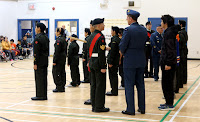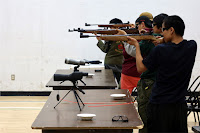Competition was in the air again at 3045 Army Cadet Corps on Saturday, October 28. The time had come for the annual Fall Biathlon Competition. Participation was voluntary.
Cadets, adult volunteers, & I arrived at the school gym in the morning for setup. Quite a bit of equipment had to be brought out to run the all-day event. We set up three shooting lanes and divided them using large wooden tables. At the far ends were white metal plinker target boxes, the kind you see at biathlon competitions. Large wooden backboards sat behind them to prevent lead pellets from hitting the gym walls. Shooting mats & small bowls were placed at the other ends for cadets. Tables & chairs were set up at the back for timekeepers, judges, cadets, a repair station, and air rifles. Two red pylons were placed near the gym doors to act as the Start Line. Thanks to the power of teamwork, everything was ready to go after 20 minutes!
Cadets selected their air rifles and practiced shooting for 45 minutes. Having practice time enables competitors to “zero-in” their rifles, get used to shooting plinker targets, work on their breathing, and improve their aim. Cadets had a short break thereafter.
I held a short briefing, reviewing how the competition would proceed for the day. Cadets would be divided into three groups based on their training years. The three groups were: Year 1, Year 2, and Year 3+. Everyone would shoot 3 times, but only the Year 1 cadets would run 2 laps. Year 2s & 3+ cadets had to run 3 laps. The running course was a 1-kilometre loop around the school. Cadets were warned to watch out for ice. I know biathlon usually involves skiing, but the bay wasn’t frozen, and I didn’t want cadets skiing up & down the local roads. The skis would get destroyed. The goal of the competition was to complete your relay in shortest amount of time. Time penalties would be given for each missed target. The amount of time varied across the three groups.
I didn’t mind the order the cadets completed their relays. They just had to get them done that day. There would only be 3 cadets completing their relays at a time. This was because there were only 3 shooting lanes and I wanted to keep timekeeping simple. Everyone’s timesheet would start at 00:00.
I
know in professional competitions, competitors start & finish at random
times on the clock forcing timekeepers to do some crazy math to determine the final
timestamps. This gets even more confusing
& tedious if there aren’t enough shooting lanes. You must stop timing a cadet while they’re
waiting for a shooting lane to become available and then start the clock again
when they begin shooting. I don’t have
time for any of that.
The cadet sergeant-major did stretch exercise with the cadets to get them ready. Cadets were then given a short break. The first three volunteers came forward thereafter.
The adult volunteers helped me with timekeeping, scoring, and replenishing the bowls with pellets. The Year 1 cadets started their relays shooting and the other two groups began their relays with running. We made sure the doors to the gym & outside were not blocked. I assigned one senior cadet to boil water outside on a Coleman stove as we neared lunchtime. We managed to get a few cadets through their relays before it was time for lunch.
A cadet corps is required to provide lunch for an all-day activity. The menu consisted of American made Meals-Ready-to-Eat (MREs). We ran out of the Canadian made Individual Meal Packages (IMPs). Cadets selected their MREs and then placed the meal pouches in the boiling water to be cooked. I chose my meal last because officers eat last in the Canadian military. The meal pouches usually need 10 – 15 minutes of cooking time. I had the cadets set up two tables with chairs & garbage bins in the middle of the gym. We also washed our hands before eating because we were handling lead pellets. Lunch lasted an hour.
The competition continued after the clean up. We continued having up to three cadets completing their relays at a time. There were only a few times when the pace felt intense for the judges. The scoresheets were placed inside an envelope, and I would grade them later. All the competing cadets were done by 3:15pm. They looked tired.
We spent a good 15 minutes putting everything away, sweeping the gym floor, and washing our hands again. The cadets were then formed up for a debriefing. I thanked them for competing and the results would be announced on Wednesday. I also thanked the adult volunteers for sacrificing their Saturday to help. I let the cadets play sports until 4pm and then let them go home with any leftover MREs.




































